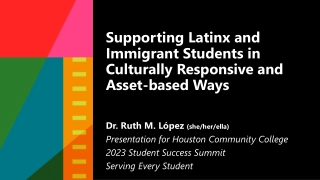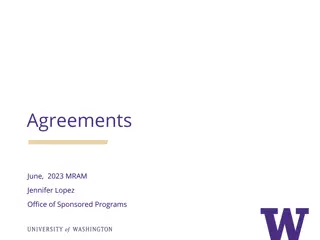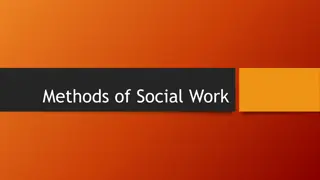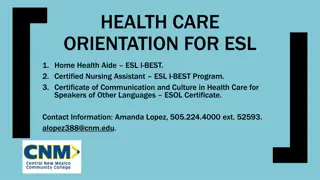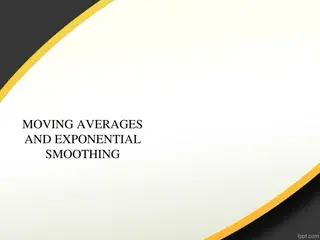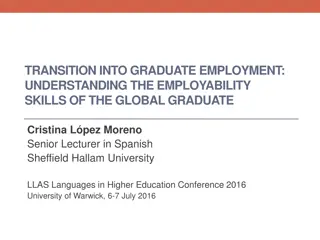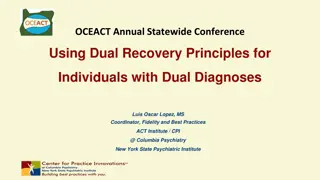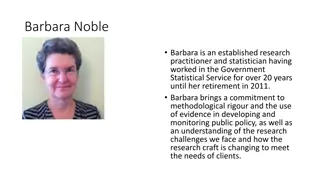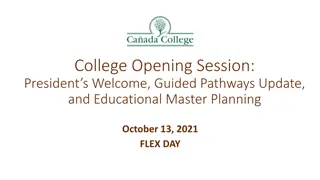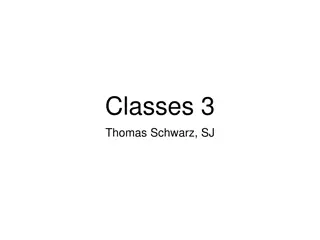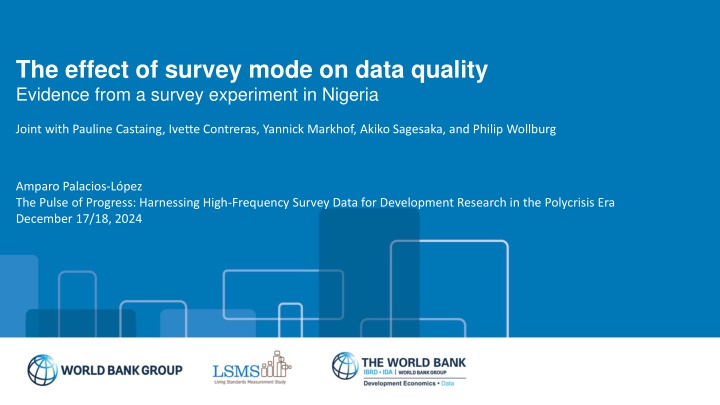
Survey Mode Impact on Data Quality: Evidence from Nigeria Experiment
This study explores the impact of survey modes on data quality in Nigeria, focusing on phone surveys in LMICs. The experiment aims to identify mode effects on various outcome variables crucial for policymakers and researchers. The research addresses gaps in pure mode effects evidence and aims to provide insights into mechanisms explaining differences between survey modes. The experimental design involves phone and in-person interviews conducted with randomly selected households, considering factors such as coverage errors, respondent selection effects, timing effects, and participation effects. Results are expected to inform survey implementation and data analysis strategies.
Download Presentation

Please find below an Image/Link to download the presentation.
The content on the website is provided AS IS for your information and personal use only. It may not be sold, licensed, or shared on other websites without obtaining consent from the author. If you encounter any issues during the download, it is possible that the publisher has removed the file from their server.
You are allowed to download the files provided on this website for personal or commercial use, subject to the condition that they are used lawfully. All files are the property of their respective owners.
The content on the website is provided AS IS for your information and personal use only. It may not be sold, licensed, or shared on other websites without obtaining consent from the author.
E N D
Presentation Transcript
The effect of survey mode on data quality Evidence from a survey experiment in Nigeria Joint with Pauline Castaing, Ivette Contreras, Yannick Markhof, Akiko Sagesaka, and Philip Wollburg Amparo Palacios-L pez The Pulse of Progress: Harnessing High-Frequency Survey Data for Development Research in the Polycrisis Era December 17/18, 2024 GPS FOR AREA MEASUREMET
2 Overview Since COVID-19 pandemic phone surveys have become commonplace in LMICs and are now often used for development economics research Have a number of attractive properties for empirical researchers and policymakers Low cost Quickly deployable Allow to survey remote and hard-to-reach areas Viable even in the face of safety issues etc. on the ground Suitable for longitudinal and high-frequency data collection Moving from traditional in-person data collection to mixed-mode data collection requires a firm grasp of the challenges and biases that come with alternative data collection modes Key issues: Uneven coverage (sampling errors) and potential mode effects (non-sampling errors) Sampling due to limited phone coverage (Ambel et al. 2021; Brubaker et al. 2021) Mode effects = Differences in measured outcomes resulting from data collection mode (e.g., in-person vs. over-the-phone) vs. This study: survey experiment to identify survey mode effects across a broad range of outcome variables relevant to policymakers and researchers in LMICs December 2024 HFPS Conference
3 Limited evidence on pure mode effects in LMICs Our work fits in with recent contributions to literature on phone survey methods Glazerman et al. (2023) JDE; Abate et al. (2023) JDE, Markhof et al. (2023), Ambler et al. (2021) JDE; Gourlay et al. (2021) Food Policy; Greenleaf et al. (2020) PLOSONE, Brubaker et al. (2021) PLOSONE, Garlick et al. (2020) WBER Consensus that mode effects important but limited evidence on pure mode effects: often unable to isolate effect of mode from that of respondent selection, timing, anchoring, etc. Mode effects likely vary depending on the topic and type of outcome measured: need for evidence base on broad range of outcomes Research questions Do measured outcomes differ depending on which survey mode is used for data collection? Do mode effects differ in different variables? What mechanisms could explain differences between survey modes? Implications for survey implementation and data analysis? December 2024 HFPS Conference
4 Experimental design Survey experiment as part of Nigeria GHS-Panel 2023/24 Distribute phones to 937 households across 106 randomly selected agricultural EAs Randomly assign respondents to answer identical questions in-person and over the phone across time Coverage errors: Distribute phones across randomly selected EAs for experiment Respondent selection effects: Target same respondent in both interviews (in-person & over phone) Timing effects: Conduct phone and in-person interview at most one week apart Anchoring/participation effects: Randomly vary the order of the in-person and phone interview: One group starts with phone interview, the other group starts with in-person interview restrict comparison between survey modes to first-time respondents December 2024 HFPS Conference
5 Experimental Design Nigeria General Household Survey Panel Sample (5,067 households) 937 households selected for phone distribution, randomly assign in T1, T2 In-person Interview (M=0) Phone Interview (M=1) Phone Interview (M=1) T1 Treatment Group 1 (T1) Treatment Group 2 (T2) T2 N=416 N=440 Remaining sample time 856 households interviewed successfully across both arms (~91%) Two respondents surveyed in 67% of households 48% women; 53% men December 2024 HFPS Conference
6 Variables of interest Subjective wellbeing Health Service access Labor Food security Migration intentions Household-level Individual-level Binary Health episodes/illnesses Health service access Migration intentions Labor Hours worked in household agricultural activities Continuous Health expenditure (6 or 12-month recall) Count Food consumption score Dietary Diversity Score Subjective wellbeing (scale) Categorical Subjective wellbeing (happiness) Climate change perceptions Locus of control December 2024 HFPS Conference
7 Empirical strategy - Exploiting random allocation of households into survey mode Nigeria General Household Survey Panel Sample (5,067 households) 937 households selected for phone distribution In-person Interview (M=0) Phone Interview (M=1) Phone Interview T1 Treatment Group 1 (T1) Treatment Group 2 (T2) T2 N=416 N=440 Remaining sample time Comparing the phone interview of Treatment Group 1 to the in-person interview of Treatment Group 2 provides a clean estimate of the survey mode effect (between design) ?? = ?0+ ?1?? + ?? Use sample of household main respondents for balance For ease of presentation, we standardize all outcome variables as follows: ?? = (?? ?)/ ? , where ? and ? are the mean and standard deviation in the in-person group. December 2024 HFPS Conference
8 Empirical strategy - Exploiting within-respondent variation Nigeria General Household Survey Panel Sample (5,067 households) 937 households selected for phone distribution In-person Interview (M=0) Phone Interview (M=1) Phone Interview T1 Treatment Group 1 (T1) Treatment Group 2 (T2) T2 N=416 N=440 Remaining sample time Comparing the phone interview of Treatment Group 1 to the in-person interview of Treatment Group 1 and the in- person interview of Treatment Group 2 to the phone interview of Treatment group 2 provides an alternative estimate of the survey mode effect (within design) ?? ?= ?0+ ?1?? ?+ ?? ? No concern about respondent selection effects since it s the same person, but concern of anchoring effects For ease of presentation, we also standardize all outcome variables. December 2024 HFPS Conference
9 Mode effects: Between design (first-time respondents) December 2024 HFPS Conference
10 Mode effects: Between design (first-time respondents) (1) (2) (3) (4) (5) (6) (7) (8) (9) (10) (11) Life controlled by accidental happenings Life Life Consulted health practitioner determined by own actions determined by others in HH Weather extremes likelihood Illness in last 30 days Wellbeing (self) Wellbeing (neighbors) Wellbeing (friends) Wellbeing (in 5y) Income adequacy Phone interview 0.218*** 0.473*** -0.455*** -0.409*** -0.316*** 0.415*** -0.227*** 0.754*** 0.235*** 0.916*** -0.0298 (0.0693) (0.0673) (0.0810) (0.0861) (0.0884) (0.0755) (0.0696) (0.0775) (0.0691) (0.0778) (0.0692) Constant 5.52e-09 6.21e-09 9.24e-09 2.55e-09 -5.83e-09 7.62e-09 -2.10e-08 -1.10e-09 1.49e-08 2.33e-08 -3.38e-09 (0.0481) (0.0481) (0.0481) (0.0481) (0.0481) (0.0481) (0.0481) (0.0481) (0.0481) (0.0481) (0.0486) Observations Note: OLS regressions of various standardized outcomes on a dummy for the survey mode of the interview. Sample: First-time respondents. Robust standard errors in parentheses. *** p<0.01, ** p<0.05, * p<0.1. 852 852 848 835 837 843 850 850 850 850 822 December 2024 HFPS Conference
11 Mode effects: Between design (first-time respondents) (12) (13) (14) (15) (16) (17) (18) (19) Hours Total health expenditures in the last 12 months in NGN10000 worked/helped in household agriculture in last 7 days Household Dietary Diversity Score (7 day) Food Any health expenditure in last 12 months Worked in the past 7 days consumption score Raw HE in the last 12 months Any shock since 2022 Phone interview 0.115* -0.252*** 0.169** 0.634*** 0.644*** 0.401*** 1.173*** 1.392*** (0.0656) (0.0904) (0.0730) (0.0731) (0.0589) (0.0517) (0.0729) (0.214) Constant -8.28e-09 1.77e-09 8.97e-09 -1.21e-10 -1.49e-08 -1.61e-08 8.28e-09 -4.23e-09 (0.0481) (0.0651) (0.0481) (0.0481) (0.0481) (0.0481) (0.0481) (0.103) Observations Note: OLS regressions of various standardized outcomes on a dummy for the survey mode of the interview. Sample: First-time respondents. Robust standard errors in parentheses. *** p<0.01, ** p<0.05, * p<0.1. 849 486 848 848 849 849 849 381 December 2024 HFPS Conference
12 Mode effects: Within design (same respondents) December 2024 HFPS Conference
13 Mode effects: Within design (same respondents) (1) (2) (3) (4) (5) (6) (7) (8) (9) (10) (11) Life controlled by accidental happenings Life Life Consulted health practitioner determined by own actions determined by others in HH Weather extremes likelihood Illness in last 30 days Wellbeing (self) Wellbeing (neighbors) Wellbeing (friends) Wellbeing (in 5y) Income adequacy Phone interview 0.151*** 0.381*** -0.441*** -0.424*** -0.344*** 0.289*** -0.249*** 0.763*** 0.259*** 0.891*** 0.0154 (0.0493) (0.0481) (0.0569) (0.0585) (0.0615) (0.0550) (0.0488) (0.0552) (0.0487) (0.0558) (0.0502) Nbr of days between interviews -0.00151 -0.00228 -0.00468** -0.00441* 0.00182 -5.96e-05 0.00167 -0.0101*** 0.00331** -0.000565 -0.00204 (0.00264) (0.00261) (0.00206) (0.00266) (0.00368) (0.00300) (0.00261) (0.00238) (0.00162) (0.00333) (0.00324) Constant 6.58e-09 8.58e-09 -1.64e-08 4.42e-09 -5.37e-09 -7.56e-09 -1.22e-09 2.08e-09 -1.59e-08 -0 -1.36e-08 (0.0346) (0.0346) (0.0348) (0.0352) (0.0351) (0.0349) (0.0347) (0.0347) (0.0347) (0.0347) (0.0362) Observations Note: OLS regressions of various standardized outcomes on a dummy for the survey mode of the interview. Sample: Identical respondents interviewed via phone or face-to-face in random order. Robust standard errors in parentheses. *** p<0.01, ** p<0.05, * p<0.1. 1,668 1,668 1,654 1,618 1,620 1,638 1,660 1,660 1,660 1,660 1,530 December 2024 HFPS Conference
14 Mode effects: Within design (same respondents) (12) (13) (14) (15) (16) (17) (18) (19) Hours Total health expenditures in the last 12 months in NGN10000 worked/helped in household agriculture in last 7 days Paid for health expenditures in the last 12 months Household Dietary Diversity Score Food Operated an NFE in the past 12 months Affected by a shock since January 2022 Consumption Score Raw Being employed Phone interview 0.214*** -0.158** 0.0962 0.625*** 0.586*** 0.378*** 1.078*** 1.504*** (0.0374) (0.0657) (0.0712) (0.0695) (0.0509) (0.0422) (0.0605) (0.299) Nbr of days between interviews 0.00186 0.00356 0.00810*** 0.00290 -0.00322 0.000268 5.64e-05 -0.00277 (0.00298) (0.00392) (0.00305) (0.00248) (0.00365) (0.00190) (0.00380) (0.00467) Constant 0.00186 6.52e-09 1.95e-08 -1.67e-10 9.75e-09 -0 2.70e-09 -9.40e-10 (0.00298) (0.0468) (0.0453) (0.0453) (0.0409) (0.0393) (0.0418) (0.0971) Observations Note: OLS regressions of various standardized outcomes on a dummy for the survey mode of the interview. Sample: Identical respondents interviewed via phone or face-to-face in random order. Robust standard errors in parentheses. *** p<0.01, ** p<0.05, * p<0.1. 2,474 912 974 974 1,198 1,292 1,146 212 December 2024 HFPS Conference
15 Mode effects: Both design December 2024 HFPS Conference
16 Empirical strategy Heterogeneity in survey mode effects To improve our understanding of the survey mode effects, we examine the effect of survey mode conditional on the following covariates: o o o o Respondent characteristics: gender, household size, household head status, educational level, residential zones in Nigeria Enumerator characteristics: gender, age, survey experience (number of surveys conducted in the past) Differences between respondent and enumerator in gender, age, and educational level Interview characteristics: main language of interview matches the respondent s spoken language, main language of interview matches the enumerator s spoken language We estimate the heterogeneity in mode effects as follows : ?? = ?0+ ?1?? + ?2?? + ?3?? ?? + ?? We conduct the heterogeneity analysis across both specifications (between and within designs) and all outcomes. ?3provides an estimate of how the effect of survey mode changes with the covariate. ?1 captures the effect of the mode effect on the outcome when the covariate is set to 0. ?1+ ?3 represents the total mode effect when the binary covariate is set to 1. For ease of presentation, all outcomes have been standardized. December 2024 HFPS Conference
17 The direction of mode effect on some wellbeing outcomes differs with the gender of enumerator December 2024 HFPS Conference
18 Mode effects on household enterprise and agricultural labor participation are smaller for main respondents but remain present December 2024 HFPS Conference
19 Overview of results from the heterogeneity analysis Health Health Wellbeing Wellbeing Wellbeing Wellbeing Wellbeing LOC LOC LOC Weather Female enumerator Age of enumerator Enumerator experience Female respondent Respondent hh size HH head respondent Age of respondent Education of respondent Resp/enum same gender Age enum Age resp Educ enum educ resp Interview conducted in a language spoken at home by respondent Interview conducted in a language spoken by enumerator Increases the mode effect Neutral Decreases the mode effect December 2024 HFPS Conference
20 Overview of results from the heterogeneity analysis Employed Hours in ag HDDS FCS Any NFE Any shock Any health Exp Female enumerator Age of enumerator Enumerator experience Female respondent Respondent hh size HH head respondent Age of respondent Education of respondent Resp/enum same gender Age enum Age resp Educ enum educ resp Interview conducted in a language spoken at home by respondent Interview conducted in a language spoken by enumerator December 2024 HFPS Conference
21 Summary and conclusions Design survey experiment to measure pure mode effects between phone and in-person interviewing across wide range of outcomes Control for a number of possible threats to identification Findings suggest significant and economically important mode effects across both specifications and across all question types No/limited evidence of anchoring effects Some evidence that the magnitude and direction of mode effects is influenced by enumerator covariates Additional analysis planned on Endowment effects / incentives Length of interviews / placement in the questionnaire Response patterns (bias towards yes or no) What may explain the mode effects? Hypotheses? December 2024 HFPS Conference
22 Stay connected with LSMS GET UPDATES Worldbank.org/lsms World Bank's Living Standards Measurement Study lsms@worldbank.org December 2024 HFPS Conference
The effect of survey mode on data quality Evidence from a survey experiment in Nigeria Joint with Pauline Castaing, Ivette Contreras, Yannick Markhof, Akiko Sagesaka, and Philip Wollburg Amparo Palacios-L pez The Pulse of Progress: Harnessing High-Frequency Survey Data for Development Research in the Polycrisis Era December 17/18, 2024 GPS FOR AREA MEASUREMET
24 Appendix 1: Balance tables (1) F2F interview (2) Phone interview Difference N/[Clusters] Mean/SE 420 0.290 [420] [0.022] 420 49.026 [420] [0.739] 420 0.812 [420] [0.019] 420 5.576 [420] [0.172] 420 0.900 [420] [0.034] t-test Variable Female N/[Clusters] Mean/SE 432 [432] 432 [432] 432 [432] 432 [432] 432 [432] (1)-(2) -0.001 0.289 [0.022] 49.514 [0.717] 0.824 [0.018] 5.731 [0.165] 1.001 [0.041] Age 0.488 Respondent is household head 0.012 Household size 0.155 Dependency ratio 0.100* (1) (2) t-test F2F first Phone first Difference Variable N/[Clusters] Mean/SE N/[Clusters] Mean/SE (1)-(2) Household size 875 5.723 836 5.562 0.161 [443] [0.164] [424] [0.170] Dependency ratio 875 0.997 836 0.900 0.097* [443] [0.041] [424] [0.034] Female household head 875 0.239 836 0.221 0.018 [443] [0.020] [424] [0.020] Age of household head 875 53.133 836 52.931 0.202 [443] [0.695] [424] [0.696] December 2024 HFPS Conference
25 Appendix 2: Survey questions During the last 4 weeks, did you suffer from an illness or injury? During the past 4 weeks have you consulted a health practitioner or dentist or traditional healer or a Patient Medicine Vendor or visited a health centre? I would now like to know about your general wellbeing. Imagine ten steps, at the top of the ladder are the people who are the best off, those who have the most money, most education, and best jobs. At the bottom are the people who are the worst off, those who have the least money, least education, worst jobs, or no job. A. On which step are you today? B. On which step are most of your neighbors today? C. On which step are most of your friends today? Considering the level of your current household income, would you say that you are living well fairly well fairly with difficulty Please indicate the degree to which you agree with each of the following statements. Disagree/ Neither Agree nor disagree/ Agree. A. To a great extent, my life is controlled by accidental happenings B. My life is determined by my own actions. C. I feel like what happens in my life is mostly determined by others in my household. How likely is it that extreme weather events will negatively affect you and your household financially during the next 12 months? D. On which step do you expect to be in 5 years? December 2024 HFPS Conference
26 Appendix 2: Survey questions Labor: In the last seven days, did you do any work for someone who is not a member of this household for payment in cash or in-kind? In the last seven days, did you work in a non-farm household business that you operate, for one or more hours? In the last seven days, did you work on household farming, raising livestock, fishing or forestry activities, for one or more hours? How many hours did you work or help on a household farming, raising livestock, fishing or forestry activities in the last seven days? FCS/HDDS: Over the past 7 days, how many days did you or others in your household consume any [...]? Grains and Flours; Starchy roots tubers and plantains; pulses, nuts and seeds; etc. Health expenditure: Over the past 12 months, did the household purchase or pay for any health expenditure? In total, how much did the household spend on health expenditure in the past 12 months? NFE: During the past 12 months, has anyone in your household YES/NO for 8 categories Shock: Since January 2022, has your household been affected by...? YES/NO for 28 categories December 2024 HFPS Conference
27 Appendix 3: Additional information on the experimental setting 937 phones and sim cards distributed to households during the post-planting visit Incentive : 1,500 Naira Credit (~ $1) per respondent; up to 3,000 Naira per household Target of 5 days between the in-person survey and the phone survey 4 previous rounds were administered before mm5 The targeted main respondent for mm5 was the household member that answered most of the previous phone interviews. Household Response rate for the phone survey was 93% December 2024 HFPS Conference
28 Implementation of treatment status on the field Longer time interval for the households that were called after +1 day on average The delay is mainly explained because the synchronization issues from the GHS-Panel, some teams didn t have access to good internet Our models should control by this variable
29 Number and profile of respondents in MM5 o 280 households with one respondent and 576 households with two respondents o Profile of the respondents: 53% are heads of household 27% are spouses 48% are women o Profile of the main respondents: 81% are heads of household 9% are spouses 29% are women o Profile of the second respondents: 13% are heads of household 54% are spouses 75% are women Administering the questionnaire to a second respondent increased the representation of women in data collection
30 Empirical strategy Tackling anchoring effects Nigeria General Household Survey Panel Sample (5,067 households) 937 households selected for phone distribution In-person Interview (M=0) Phone Interview (M=1) Phone Interview (M=1) T1 (V=2) Treatment Group 1 (T1) Treatment Group 2 (T2) T2 (V=1) Interview 1 (V=1) Interview 2 (V=2) Remaining sample time Difference-in-differences estimation ?? ?= ?0+ ?1?? ?+ ?2?? ?+ ?3?? ? ?? ?+ ?? ? Interaction term captures anchoring effects December 2024 HFPS Conference
31 Anchoring effects: Difference in differences December 2024 HFPS Conference
32 Anchoring effects: difference in differences (1) (2) (3) (4) (5) (6) (7) (8) (9) (10) (11) Life controlled by accidental happenings Life Life Consulted health practitioner determined by own actions determined by others in HH Weather extremes likelihood Illness in last 30 days Wellbeing (self) Wellbeing (neighbors) Wellbeing (friends) Wellbeing (in 5y) Income adequacy Phone interview Respondent previously interviewed -0.157 -0.210** 0.0499 0.0138 -0.0271 -0.259** -0.0533 0.0202 0.0482 -0.00789 0.135 (0.109) (0.106) (0.128) (0.124) (0.131) (0.121) (0.104) (0.117) (0.0988) (0.117) (0.102) Phone interview 0.230*** 0.485*** -0.467*** -0.432*** -0.331*** 0.419*** -0.223*** 0.753*** 0.233*** 0.896*** -0.0535 (0.0696) (0.0673) (0.0814) (0.0855) (0.0886) (0.0780) (0.0689) (0.0777) (0.0698) (0.0785) (0.0714) Respondent previously interviewed (F2F or over phone) 0.0655 0.126* 0.0183 0.0415 0.00715 0.128* 0.0510 -0.00907 0.0220 -0.0445 0.00446 (0.0693) (0.0692) (0.0696) (0.0704) (0.0704) (0.0697) (0.0695) (0.0695) (0.0695) (0.0695) (0.0724) Constant -0.0321 -0.0616 -0.00896 -0.0201 -0.00347 -0.0622 -0.0250 0.00444 -0.0108 0.0218 -0.00218 (0.0482) (0.0481) (0.0487) (0.0487) (0.0485) (0.0499) (0.0476) (0.0480) (0.0485) (0.0485) (0.0503) Observations 1,668 1,668 1,654 1,618 1,620 1,638 1,660 1,660 1,660 1,660 1,530 Note: OLS regressions of various outcomes on a dummy for the survey mode of the interview, fully interacted with a dummy for whether the respondent had been previously interviewed (either over the phone or in person). Sample: Identical respondents interviewed via phone or face-to-face in random order. Robust standard errors in parentheses. *** p<0.01, ** p<0.05, * p<0.1. December 2024 HFPS Conference
33 Anchoring effects: difference in differences (12) (13) Hours (14) (15) (16) (17) (18) (19) worked/help ed in household agriculture in last 7 days Paid for health expenditures in the last 12 months Total health expenditures in the last 12 months in NGN10000 Household Dietary Diversity Score Operated an NFE in the past 12 months Food Affected by a shock since January 2022 Being employed Consumption Score Raw Phone interview Respondent previously interviewed 0.0381 0.187 -0.0458 -0.0275 -0.0938 -0.0692 -0.0893 -0.520 (0.0978) (0.173) (0.156) (0.145) (0.112) (0.0843) (0.126) (0.645) Phone interview 0.102 -0.271** 0.117 0.636*** 0.633*** 0.411*** 1.121*** 1.730*** (0.0626) (0.108) (0.100) (0.0991) (0.0708) (0.0604) (0.0848) (0.418) Respondent previously interviewed (F2F or over phone) 0.00322 -0.0534 0.0637 0.0725 0.0364 0.0634 0.0825 -0.109 (0.0654) (0.112) (0.0910) (0.0909) (0.0818) (0.0786) (0.0838) (0.207) Constant 0.121*** 0.0964 -0.0301 -0.0342 -0.0176 -0.0309 -0.0395 0.0596 (0.0457) (0.0773) (0.0618) (0.0622) (0.0569) (0.0566) (0.0565) (0.188) Observations Note: OLS regressions of various outcomes on a dummy for the survey mode of the interview, fully interacted with a dummy for whether the respondent had been previously interviewed (either over the phone or in person). Sample: Identical respondents interviewed via phone or face-to-face in random order. Robust standard errors in parentheses. *** p<0.01, ** p<0.05, * p<0.1. 1,602 670 974 974 1,198 1,292 1,146 212 December 2024 HFPS Conference
34 Empirical strategy Tackling anchoring effects Nigeria General Household Survey Panel Sample (5,067 households) 937 households selected for phone distribution In-person Interview (M=0) Phone Interview (M=1) Phone Interview (M=1) T1 (V=2) Treatment Group 1 (T1) Treatment Group 2 (T2) T2 (V=1) Interview 1 (V=1) Interview 2 (V=2) Remaining sample time Anchoring effects: answer in previous round determines answer in current survey round Strategy 1: compare within mode across treatment groups, controlling for the first or second interview ??? ????? ??????????: ?? ?= ?0+ ?1?? ?+ ?? ? ??? ?? ?????? ??????????: ?? ?= ?0+ ?1?? ?+ ?? ? December 2024 HFPS Conference
35 Anchoring effects: phone interviews December 2024 HFPS Conference
36 Anchoring effects: phone interviews (1) (2) (3) (4) (5) (6) (7) (8) (9) (10) (11) Life controlled by accidental happening s Life Consulted health practitione r Life determine d by others in HH Illness in last 30 days determine d by own actions Weather extremes likelihood Wellbeing (self) Wellbeing (nghbors) Wellbeing (friends) Wellbeing (in 5y) Income adequacy Respondent was previously interviewed in-person -0.0915 -0.0845 0.0682 0.0553 -0.0200 -0.132 -0.00224 0.0112 0.0702 -0.0524 0.139** (0.0703) (0.0668) (0.0901) (0.0938) (0.101) (0.0849) (0.0688) (0.0860) (0.0685) (0.0875) (0.0696) Constant 0.198*** 0.424*** -0.476*** -0.453*** -0.334*** 0.356*** -0.248*** 0.758*** 0.223*** 0.918*** -0.0557 (0.0503) (0.0471) (0.0652) (0.0702) (0.0741) (0.0599) (0.0498) (0.0611) (0.0502) (0.0617) (0.0507) Observations 834 834 827 809 810 819 830 830 830 830 765 Note: OLS regressions of various outcomes on a dummy for whether the respondent had been previously interviewed (in person). Sample: Phone interviews of respondents interviewed in-person and over the phone. Robust standard errors in parentheses. *** p<0.01, ** p<0.05, * p<0.1. December 2024 HFPS Conference
37 Anchoring effects: phone interviews (12) (13) (14) (15) (16) (17) (18) (19) Hours worked/help ed in household agriculture in last 7 days Paid for health expenditures in the last 12 months Total health expenditures in the last 12 months in NGN10000 Household Dietary Diversity Score Operated an NFE in the past 12 months Food Affected by a shock since January 2022 Being employed Consumption Score Raw Respondent was previously interviewed in- person 0.0413 0.133 0.0179 0.0450 -0.0574 -0.00576 -0.00684 -0.629 (0.0584) (0.108) (0.110) (0.106) (0.0606) (0.0303) (0.0876) (0.571) Constant 0.223*** -0.175** 0.0867 0.601*** 0.616*** 0.380*** 1.082*** 1.789*** (0.0428) (0.0759) (0.0791) (0.0771) (0.0421) (0.0211) (0.0632) (0.372) Observations 801 335 487 487 599 646 573 106 Note: OLS regressions of various outcomes on a dummy for whether the respondent had been previously interviewed (in person). Sample: Phone interviews of respondents interviewed in-person and over the phone. Robust standard errors in parentheses. *** p<0.01, ** p<0.05, * p<0.1. December 2024 HFPS Conference
38 Anchoring effects: in-person interviews December 2024 HFPS Conference
39 Anchoring effects: in-person interviews (1) (2) (3) (4) (5) (6) (7) (8) (9) (10) (11) Life controlled by accidental happenings Life Life Consulted health practitioner determined by own actions determined by others in HH Weather extremes likelihood Illness in last 30 days Wellbeing (self) Wellbeing (nghbors) Wellbeing (friends) Wellbeing (in 5y) Income adequacy Respondent was previously interviewed over the phone 0.0655 0.126* 0.0183 0.0415 0.00715 0.128* 0.0510 -0.00907 0.0220 -0.0445 0.00446 (0.0693) (0.0692) (0.0696) (0.0704) (0.0704) (0.0697) (0.0695) (0.0695) (0.0695) (0.0695) (0.0724) Constant -0.0321 -0.0616 -0.00896 -0.0201 -0.00347 -0.0622 -0.0250 0.00444 -0.0108 0.0218 -0.00218 (0.0482) (0.0481) (0.0487) (0.0487) (0.0485) (0.0499) (0.0476) (0.0480) (0.0485) (0.0485) (0.0503) Observations 834 834 827 809 810 819 830 830 830 830 765 Note: OLS regressions of various outcomes on a dummy for whether the respondent had been previously interviewed (over the phone). Sample: In-person interviews of respondents interviewed in-person and over the phone. Robust standard errors in parentheses. *** p<0.01, ** p<0.05, * p<0.1. December 2024 HFPS Conference
40 Anchoring effects: in-person interviews (12) (13) (14) (15) (16) (17) (18) (19) Hours Total health expenditures in the last 12 months in NGN10000 worked/helpe d in household agriculture in last 7 days Operated an NFE in the past 12 months Paid for health expenditures in the last 12 months Household Dietary Diversity Score Food Affected by a shock since January 2022 Being employed Consumption Score Raw Respondent was previously interviewed over the phone 0.00322 -0.0534 0.0637 0.0725 0.0364 0.0634 0.0825 -0.109 (0.0654) (0.112) (0.0909) (0.0908) (0.0818) (0.0786) (0.0838) (0.207) Constant 0.121*** 0.0964 -0.0301 -0.0342 -0.0176 -0.0309 -0.0395 0.0596 (0.0457) (0.0772) (0.0618) (0.0622) (0.0569) (0.0566) (0.0565) (0.187) Observations 801 335 487 487 599 646 573 106 Note: OLS regressions of various outcomes on a dummy for whether the respondent had been previously interviewed (over the phone). Sample: In-person interviews of respondents interviewed in-person and over the phone. Robust standard errors in parentheses. *** p<0.01, ** p<0.05, * p<0.1. December 2024 HFPS Conference
41 In-person outcomes contaminated by the experiment ? December 2024 HFPS Conference
Any observed differences between main and second respondents? 42 December 2024 HFPS Conference
43 Standardized vs non-standardized outcomes (1) (2) (3) (4) (5) (6) (7) (8) Life (9) (10) (11) controlled by accidental happenings Life Life Consulted health practitioner determined by own actions determined by others in HH Weather extremes likelihood Illness in last 30 days Wellbeing (self) Wellbeing (neighbors) Wellbeing (friends) Wellbeing (in 5y) Income adequacy Non Standardized Phone interview 0.107*** (0.0339) 0.398*** (0.0236) 0.233*** (0.0333) 0.419*** (0.0238) -0.797*** (0.142) 4.475*** (0.0843) -0.674*** (0.142) 4.396*** (0.0793) -0.510*** (0.143) 4.648*** (0.0777) 0.863*** (0.157) 6.833*** (0.1000) -0.197*** (0.0606) 2.248*** (0.0419) 0.561*** (0.0577) 1.688*** (0.0358) 0.163*** (0.0480) 2.514*** (0.0334) 0.680*** (0.0577) 1.581*** (0.0357) -0.0327 (0.0758) 3.165*** (0.0533) Constant Observations 852 852 848 835 837 843 850 850 Life 850 850 822 controlled by accidental happenings Life Life Consulted health practitioner determined by own actions determined by others in HH Weather extremes likelihood Illness in last 30 days Wellbeing (self) Wellbeing (neighbors) Wellbeing (friends) Wellbeing (in 5y) Income adequacy Standardized Phone interview 0.218*** (0.0693) 5.52e-09 (0.0481) 0.473*** (0.0673) 6.21e-09 (0.0481) -0.455*** (0.0810) 9.24e-09 (0.0481) -0.409*** (0.0861) 2.55e-09 (0.0481) -0.316*** (0.0884) -5.83e-09 (0.0481) 0.415*** (0.0755) 7.62e-09 (0.0481) -0.227*** (0.0696) -2.10e-08 (0.0481) 0.754*** (0.0775) -1.10e-09 (0.0481) 0.235*** (0.0691) 1.49e-08 (0.0481) 0.916*** (0.0778) 2.33e-08 (0.0481) -0.0298 (0.0692) -3.38e-09 (0.0486) Constant Observations 852 852 848 835 837 843 850 850 850 850 822 December 2024 HFPS Conference

